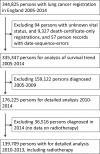Geographical variations in the use of cancer treatments are associated with survival of lung cancer patients
- PMID: 29511056
- PMCID: PMC5969334
- DOI: 10.1136/thoraxjnl-2017-210710
Geographical variations in the use of cancer treatments are associated with survival of lung cancer patients
Abstract
Introduction: Lung cancer outcomes in England are inferior to comparable countries. Patient or disease characteristics, healthcare-seeking behaviour, diagnostic pathways, and oncology service provision may contribute. We aimed to quantify associations between geographic variations in treatment and survival of patients in England.
Methods: We retrieved detailed cancer registration data to analyse the variation in survival of 176,225 lung cancer patients, diagnosed 2010-2014. We used Kaplan-Meier analysis and Cox proportional hazards regression to investigate survival in the two-year period following diagnosis.
Results: Survival improved over the period studied. The use of active treatment varied between geographical areas, with inter-quintile ranges of 9%-17% for surgical resection, 4%-13% for radical radiotherapy, and 22%-35% for chemotherapy. At 2 years, there were 188 potentially avoidable deaths annually for surgical resection, and 373 for radical radiotherapy, if all treated proportions were the same as in the highest quintiles. At the 6 month time-point, 318 deaths per year could be postponed if chemotherapy use for all patients was as in the highest quintile. The results were robust to statistical adjustments for age, sex, socio-economic status, performance status and co-morbidity.
Conclusion: The extent of use of different treatment modalities varies between geographical areas in England. These variations are not attributable to measurable patient and tumour characteristics, and more likely reflect differences in clinical management between local multi-disciplinary teams. The data suggest improvement over time, but there is potential for further survival gains if the use of active treatments in all areas could be increased towards the highest current regional rates.
Keywords: lung cancer; lung cancer chemotherapy; radiotherapy; surgery; survival.
© Article author(s) (or their employer(s) unless otherwise stated in the text of the article) 2018. All rights reserved. No commercial use is permitted unless otherwise expressly granted.
Conflict of interest statement
Competing interests: TR has a personal grant from the National Institute for Health Research during the period of this work. DRB has received personal fees from Astra Zeneca, outside the submitted work. Other authors have no competing interest to declare.
Figures




References
-
- Cancer Research UK. Lung cancer statistics. http://www.cancerresearchuk.org/health-professional/lung-cancer-statistics 2016.
Publication types
MeSH terms
Grants and funding
LinkOut - more resources
Full Text Sources
Other Literature Sources
Medical
